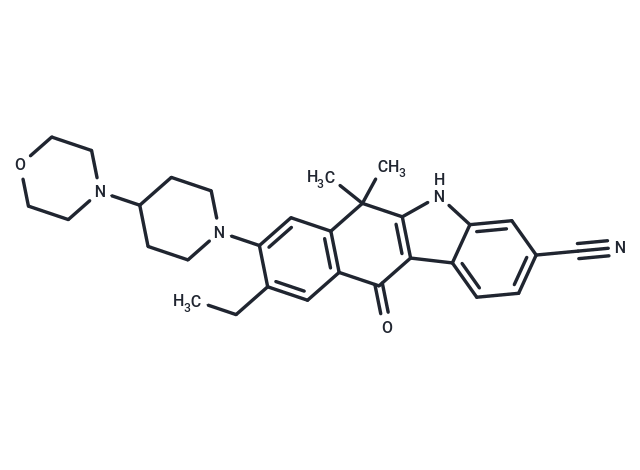Shopping Cart
- Remove All
 Your shopping cart is currently empty
Your shopping cart is currently empty

Alectinib (RG-7853) is an ALK inhibitor (IC50=1.9 nM, Kd=2.4 nM) that is selective, orally active, and ATP-competitive. Alectinib has antitumor activity and is used in the treatment of non-small cell lung cancer.

| Pack Size | Price | Availability | Quantity |
|---|---|---|---|
| 2 mg | $39 | In Stock | |
| 5 mg | $63 | In Stock | |
| 10 mg | $79 | In Stock | |
| 50 mg | $107 | In Stock | |
| 100 mg | $171 | In Stock | |
| 200 mg | $273 | In Stock | |
| 500 mg | $459 | In Stock |
| Description | Alectinib (RG-7853) is an ALK inhibitor (IC50=1.9 nM, Kd=2.4 nM) that is selective, orally active, and ATP-competitive. Alectinib has antitumor activity and is used in the treatment of non-small cell lung cancer. |
| Targets&IC50 | ALK (F1174L):1 nM, ALK (R1275Q):3.5 nM, ALK:1.9 nM |
| In vitro | METHODS: Six neuroblastoma (NB) cell lines were treated with Alectinib (0.001-50 µM) for 72 h and cell viability was measured by CCK-8 assay. RESULTS: Six NB cell lines were selected, including three ALK-WT cell lines (IMR-32, NB-19, and SK-N-AS) and three ALK-mutant cell lines (Kelly, SH-SY5Y, and LA-N-6.) Alectinib treatment dramatically reduced cell viability, with IC50s for the cell lines tested ranging from 3.181-9.6 µM.[1] METHODS: NSCLCA cells NCI-H2228 were treated with Alectinib (10-1000 nM) for 2 h, and the expression levels of target proteins were detected by Western Blot. RESULTS: Alectinib prevented the autophosphorylation of ALK in NCI-H2228 NSCLC cells expressing EML4-ALK, and Alectinib also led to a substantial inhibition of the phosphorylation of STAT3 and AKT, but not ERK1/2. [2] |
| In vivo | METHODS: To detect antitumor activity in vivo, Alectinib (25 mg/kg) was administered intraperitoneally to TH-MYCN transgenic mice every two days for 11 doses. RESULTS: Treatment with Alectinib resulted in reduced tumor growth in TH-MYCN transgenic mice.Alectinib induced PARP and Caspase 3 cleavage and blocked PI3K/Akt/mTOR signaling in TH-MYCN tumor tissue. Alectinib exposure prolonged the survival of TH-MYCN transgenic mice compared to DMSO treatment. [1] |
| Kinase Assay | Kinase inhibitory assays in Vitro: The inhibitory ability against each kinase except for MEK1 and Raf-1 is evaluated by examining their ability to phosphorylate various substrate peptides in the presence of CH5424802 using time-resolved fluorescence resonance energy transfer (TR-FRET) assay or fluorescence polarization (FP) assay. The inhibitory activity against MEK1 is evaluated by quantitative analysis of the phosphorylation of a substrate peptide by a recombinant ERK2 protein in the presence of CH5424802. The inhibitory activity against Raf-1 is evaluated by examining the ability of the kinases to phosphorylate MEK1 in the presence of CH5424802. |
| Cell Research | Cells including NSCLC, A549 and HCC827 are seeded in 96-well plates overnight and incubated with various concentrations of CH5424802 for the indicated time. For spheroid cell growth inhibition assay, cells are seeded on spheroid plates, incubated overnight, and then treated with compound for the indicated times. The viable cells are measured by the Luminescent Cell Viability Assay. Caspase-3/7 assay is evaluated using the Caspase-Glo 3/7 Assay Kit.(Only for Reference) |
| Alias | RG-7853, CH5424802, AF-802, AF802 |
| Molecular Weight | 482.62 |
| Formula | C30H34N4O2 |
| Cas No. | 1256580-46-7 |
| Smiles | CCc1cc2C(=O)c3c([nH]c4cc(ccc34)C#N)C(C)(C)c2cc1N1CCC(CC1)N1CCOCC1 |
| Relative Density. | 1.28 |
| Storage | Powder: -20°C for 3 years | In solvent: -80°C for 1 year | Shipping with blue ice. | |||||||||||||||||||||||||
| Solubility Information | H2O: 2.1 mM, Sonication is recommended. DMSO: 4.83 mg/mL (10 mM), Sonication is recommended. | |||||||||||||||||||||||||
Solution Preparation Table | ||||||||||||||||||||||||||
H2O/DMSO
DMSO
| ||||||||||||||||||||||||||

Copyright © 2015-2025 TargetMol Chemicals Inc. All Rights Reserved.